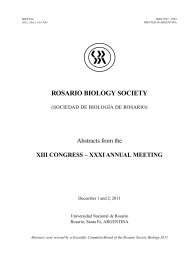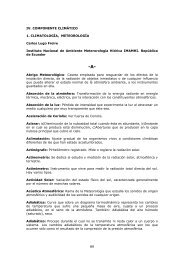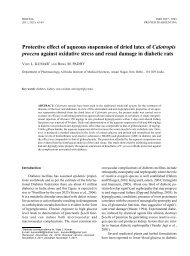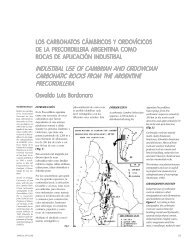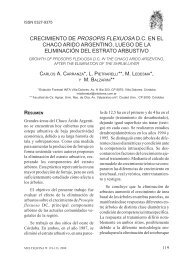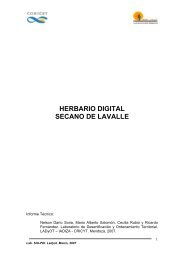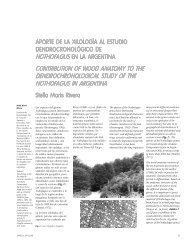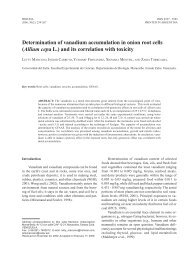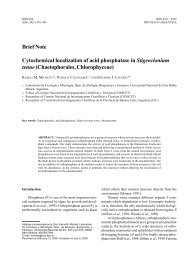XXII Annual Scientific Meeting, Tucuman Biology Society ...
XXII Annual Scientific Meeting, Tucuman Biology Society ...
XXII Annual Scientific Meeting, Tucuman Biology Society ...
You also want an ePaper? Increase the reach of your titles
YUMPU automatically turns print PDFs into web optimized ePapers that Google loves.
210 ABSTRACTS<br />
177.<br />
COOPER ACCUMULATION IN ROOTS, STEMS AND<br />
LEAVES OF A FOOD PLANT<br />
Benimeli CS 2 , Medina A 2 , Navarro CM 1 , Medina RB 2 , Amoroso MJ 2 ,<br />
Gomez MI 1 .<br />
1 Cát. Qca. and 2 Qca. Biológica. Fac. Cs. de la Salud. UNSTA. 9 de<br />
Julio 169. (4000) S M Tucumán. E-mail: minesgomez@arnet.com.ar<br />
Plants metal biosorption are affected by species, growth and chemical<br />
elements characteristics. In Tucumán there is a copper filter<br />
plant that produces metal contamination in agriculture surrounding<br />
areas. The aim of this work was to determine Cu accumulation<br />
in maize plant and its capacity of growth. Maize seeds were germinated<br />
in sterile, humid and dark conditions at 30 °C for 3 days,<br />
being later seeded in an inert material. The plants were watered 10<br />
days with nutritive broth, 6 more with also CuSO 4 250 mg/L and<br />
kept at 30 °C with light cycles of 12 h. The growth was evaluated<br />
in roots, stems and leaves. Cu accumulation was measured by atomic<br />
absorption spectrophotometer. A growth diminution of 10% in roots<br />
and leaves was observed compared to the controls. Only steams<br />
and leaves presented 16 and 13% weights reduction. Steams Cu<br />
accumulation was 93% more than the controls, however in roots<br />
and leaves were 83 and 86%. The capacity of Cu(II) accumulation<br />
by a food plant, could be prejudicial for the trophic chain because<br />
their toxicity in high concentrations<br />
178.<br />
ELICITATION OF DEFENSE REACTIONS IN<br />
STRAWBERRY (Fragaria x ananassa) BY ELICITOR<br />
DERIVED FROM Colletotrichum<br />
Chalfoun NR, Arias ME, Salazar SM, Castagnaro AP, Díaz Ricci JC.<br />
INSIBIO (CONICET-UNT). Chacabuco 461. CP 4000. Sección<br />
Biotecnología de la EEAOC. Tucumán.<br />
E-mail: nadiarchalfoun@hotmail.com<br />
The oxidative burst generating reactive oxygen species (ROS: H O , 2 2<br />
- O ) is one of the earliest plant responses activated by a defense<br />
2<br />
elicitor. Accumulation of H O can trigger cell wall thickening, in-<br />
2 2<br />
duction of defense genes and a localized cell death called hypersensitive<br />
response (HR). The aim of the study was to analyze the<br />
occurrence of defense reactions in response to a fungal elicitor in<br />
strawberry plants. The elicitor was obtained from culture filtrate of<br />
an avirulent strain of Colletotrichum fragariae and infiltrated on<br />
the abaxial surface of two leaves per plant of the cultivar Pájaro.<br />
Histochemical localization of H O showed spread micro-bursts in<br />
2 2<br />
treated leaves with a maximum accumulation four hours after infiltration.<br />
In the same areas we have also detected the reinforcement<br />
of mesophyll cell wall due to the apposition of lignin and the<br />
swelling of few adaxial epidermal cells followed by their collapse<br />
24 hours latter. HR cell death was visualized at infiltration sites by<br />
yellow autofluorescence under UV-light (310 nm) excitation indicating<br />
the accumulation of polyphenols. Our results indicate that<br />
the H O burst is closely associated with HR and the lignification.<br />
2 2<br />
These local defense responses induced a systemic protection when<br />
plants were challenged with a virulent pathogen.<br />
BIOCELL 30(1), 2006<br />
179.<br />
ANALYSIS OF TISSUE TYPE PLASMINOGEN ACTIVATOR<br />
(t-PA) IN PORCINE OVIDUCT<br />
Roldán-Olarte M, Valdecantos P, Miceli DC.<br />
Instituto de Biología. Facultad de Bioquímica, Química y Farmacia.<br />
INSIBIO. UNT. Chacabuco 461. 4000. San Miguel de Tucumán. Email:<br />
emroldanolarte@fbqf.unt.edu.ar<br />
Plasminogen activators are highly specific serine-proteases that<br />
convert plasminogen to plasmin, an active protease with a very<br />
broad spectrum of substrates. In previous works, we determined<br />
the activity of plasminogen activators and the expression of urokinase<br />
type plasminogen activator (u-PA) in the epithelium of the<br />
porcine oviduct. The aim of this work was to demonstrate that tissue<br />
type plasminogen activator (t-PA) is synthesized and secreted<br />
in the porcine oviduct as well as to study the differences between<br />
the phases of the estrous cycle. Western Blot assays performed with<br />
oviductal fluid obtained in the follicular and luteal phases, by using<br />
a monoclonal antibody against t-PA, showed a band of 72 kDa<br />
corresponding to MW reported for porcine t-PA. The presence of t-<br />
PA was observed in both phases of the estrous cycle. The t-PA concentration<br />
was higher in samples obtained during follicular phase<br />
than luteal phase. The expression of t-PA gene studied by semiquantitative<br />
RT-PCR in both ampulla and isthmus oviductal regions<br />
indicated no significant differences between both segments. When<br />
we studied the t-PA gene in the epithelial cells, an up-regulated<br />
expression during the follicular phase in this tissue was observed.<br />
According to these results, the presence of t-PA in epithelial cells<br />
was also confirmed by immunohistochemical assays. This work<br />
indicates that the t-PA is synthesized in the porcine oviduct and<br />
secreted to the oviductal lumen, where it could activate plasminogen<br />
to plasmin near gametes or embryos. This enzyme could act<br />
directly or indirectly on the extracellular matrix (ECM) components<br />
in the last case by activating matrix metalloproteases or grow<br />
factors present in the ECM.<br />
180.<br />
REACTIVATES SEROLOGY FOR TRANSMISSIBLE<br />
DISEASES BY TRANSFUSIONS IN DONORS OF THE<br />
PROVINCE OF TUCUMÁN AT OFFICIAL LEVEL. PERIOD<br />
2004<br />
Arenas Hernández M de los A, De Rosa R, Guzmán A del V, Guzmán<br />
MJ, Martorell Ortiz M del C, Gramajo Antuz GE.<br />
Av. Avellaneda 750. SM de Tucumán, Tucumán. CP 4000.<br />
Chacabuco 525. E-mail: rodrigoderosa@hotmail.com<br />
Descriptive, transversal cohort study, over 12,981 donors from<br />
Tucumán official data base (Argentina) Period 2004. Objectives:<br />
Describe the frequency of reactive serology for transmissible disease<br />
by transfusions (TDT) in blood donors and discriminate it<br />
according to the type of disease. The information was obtained of<br />
the Tucumán official data base. Exclusion Criteria: Samples without<br />
pertinent studies. Descriptive study of variables was made.<br />
Reactive serology presented in 1567(12%) on 12,981 donors. The<br />
most frequently diseases founded were: Chagas 7%(862 cases), anti-<br />
HBcore 4%(454), anti-HCV 1,4%(185), HBsAg, 1%(129), the rest<br />
was presented in less of 0,4%. Comparing the frequency founded<br />
(12%) with studies that used normatized systems of tamizaje (4%)<br />
was observated a greater significantly difference. The differences<br />
with the studies descripted would indicate that it would be necessary<br />
to fit the tamizaje methods.



